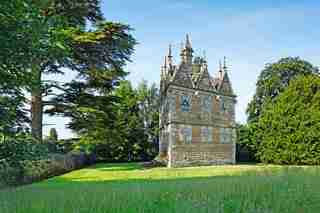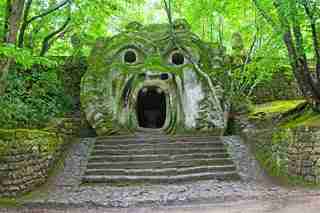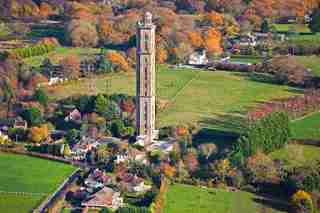
dam-images-daily-2014-12-garden-follies-garden-follies-01.jpg
Triangular Lodge, Northamptonshire, England
Sir Thomas Tresham, a Roman Catholic, was imprisoned for 15 years for refusing to convert to Protestantism. Upon his release, he built this testament to his faith in 1597, which repeatedly invokes the Holy Trinity by using multiples of three in its design, including three 33-foot-long walls, three floors, triangular windows, and a triangular chimney.

dam-images-daily-2014-12-garden-follies-garden-follies-02.jpg
Park of Monsters Ogre, Bomarzo, Italy
In the late 1500s, Italian duke Pier Francesco Orsini was so heartbroken by the death of his wife, Giulia Farnese, that he commissioned architect Pirro Ligorio and sculptor Simone Moschino to create a fantastical outdoor world to ease his pain. In addition to this child-eating ogre (also referred to as an orc or orcus), the garden’s labyrinthine paths lead visitors to dragons, a three-headed hound, bears, and Hercules.

dam-images-daily-2014-12-garden-follies-garden-follies-05.jpg
Sway Tower, Hampshire, England
Many follies are known by their creators’ names, and so the Sway Tower is also called Peterson’s Folly after Andrew Thomas Turton Peterson, who erected the spectacular 13-story, 218-foot-tall building on his estate in 1886. Peterson, a lawyer and spiritualist, mimicked the follies he had seen in India in both design and construction, exclusively using concrete (aside from iron window supports). It is believed to be the tallest non-reinforced-concrete structure in the world.
dam-images-daily-2014-12-garden-follies-garden-follies-03.jpg
The Dunmore Pineapple, Falkirk, Scotland
According to one account, the Earl of Dunmore built the pineapple dome, circa 1777, as a birthday present for his wife; another story claims it was an elaborate joke by the earl to announce his return home after being forcibly removed from his position as the colonial governor of Virginia. All sources agree that the family used the building to grow tropical fruits, including pineapples, and that the dome’s masonry is a masterpiece of cantilevered leaves and overall verisimilitude.
dam-images-daily-2014-12-garden-follies-garden-follies-06.jpg
Masonic Initiation Pit, Quinta da Regaleira Estate, Sintra, Portugal
This inverted tower, plunging 88 feet into the earth and with passages connecting it to other parts of the palace property, is rumored to have been the site of Masonic initiation rites. The well, constructed circa 1910, consists of stairs and landings arranged in a way that supposedly represents tarot mysticism, and at its bottom, a marble floor features the cross of the Knights Templar.
dam-images-daily-2014-12-garden-follies-garden-follies-04.jpg
Belvedere Castle, New York
Architect Calvert Vaux picked this high point in Central Park to erect in 1869 a Victorian folly in the form of a functionless miniature castle. Belvedere, which means “beautiful view” in Italian, offers panoramic views that include the Great Lawn, the Ramble, and the Delacorte Theater. In 1919 the National Weather Service began measuring wind speed and direction from the tower, and over the years the building has served as a set for productions ranging from Merchant Ivory’s The Bostonians to Sesame Street.
dam-images-daily-2014-12-garden-follies-garden-follies-07.jpg
Tartar Tent, Château de Groussay, Montfort l’Amaury, France
The globe-trotting Frenchman Charles de Beistegui bought Château de Groussay in 1938, almost 125 years after it had been built. He then transformed its grounds into a wonderland of global references, with follies inspired by travels to India, Mexico, and all of Europe. In addition to constructing an observatory, a pagoda, a pyramid, and a “Love Temple” reminiscent of the Trianon, he erected this Tartar Tent of painted metal in 1960, lining its interior with 10,000 Delft tiles.
dam-images-daily-2014-12-garden-follies-garden-follies-08.jpg
Parc de la Villette, Paris, France
When the city of Paris hosted an international competition in 1982 for the design of a park that had once been the grounds of its largest slaughterhouse and meat market, it was inundated with more than 470 entries. The winner was Bernard Tschumi, whose conception of an 'urban park for the 21st century' was the opposite of Frederick Law Olmsted’s view of parks as escapes from the surrounding city. Tschumi designed 26 red follies, constructed from 1982 to 1998, to be pleasing counterpoints to the background of green trees and grass. Each folly is unique in shape, although all refer to the same basic cube form and proportions.
dam-images-daily-2014-12-garden-follies-garden-follies-09.jpg
Yorkshire Lavender Farm Memorial Pyramids, Terrington, England
When Nigel Goodwill’s wife died of breast cancer in 1993, he was left to raise their two small children, then ages five and three. To meet the increased parenting demands, he quit his job and bought a farm, where he planted lavender. The business—and the children—thrived, and at the center of a memorial garden named after his wife, Goodwill erected these four metal pyramids to represent each member of the family.
dam-images-daily-2014-12-garden-follies-garden-follies-10.jpg
Serpentine Gallery Pavilion, London
Since 2000, the Serpentine Gallery has called on top architects to design temporary structures next to its Kensington Gardens gallery. The buildings, which stand only one summer, attract up to 250,000 visitors. The 2014 construction was by Chilean architect Smiljan Radić, who used fiberglass and rough-cut rocks to create his own version of an 18th-century folly, borrowing from the earlier buildings their “extravagance, ambience, [and] atmosphere.” Critics enthusiastically likened its shape to everything from spaceships to dinosaur eggs and turtles, and Robert Bevan, the architecture critic for the Evening Standard, observed that Radić’s translucent orb was both romantic and madcap.
